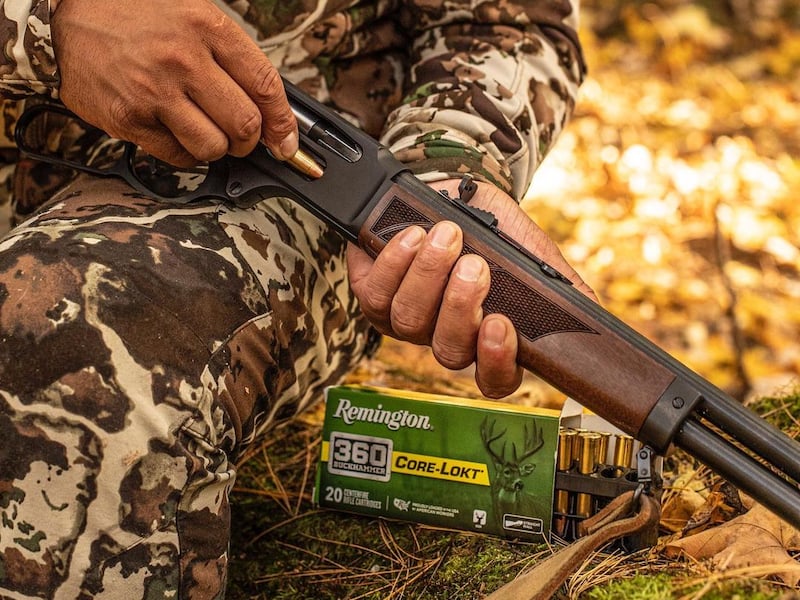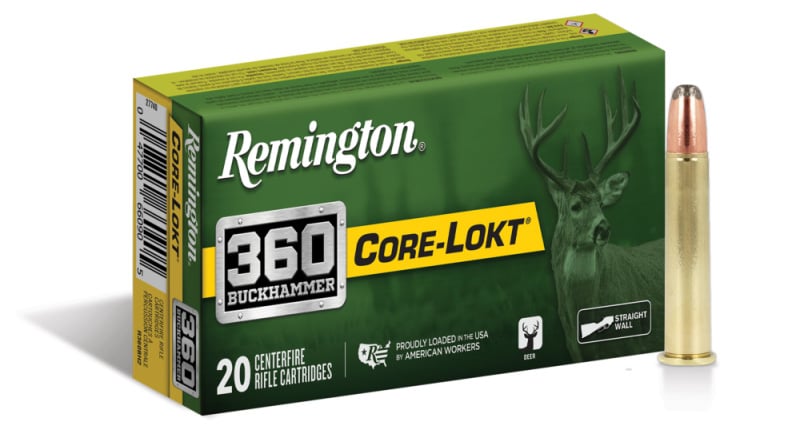Hunting regulations vary from state to state and from reasonable to arcane. We, as hunters, understand why it is illegal in almost all states to hunt whitetail with rifles chambered in .22 rimfire. Possible? Yes. Ethical, no. At the same time, the minimum muzzleloading caliber in some states is .40 caliber, even though that caliber is underpowered for the same game. Similarly, urbanized states like Michigan and Illinois banned the use of conventional rifles for deer hunting. For fear of errant bullets that could carry on for miles, legislators mandated that hunters across states like these can only hunt with either a shotgun or a muzzleloader. Now, those same bodies have green-lit straight-wall cartridges for deer hunting. Here is the why behind straight wall cartridges and a few popular options that have their advantages and disadvantages.

The Rebirth of Straight Wall Cartridges
In the early days of cartridge guns, the lion’s share of rifle rounds featured black powder loaded in straight wall cases. Whether your game was hunting game or shooting at long-distance targets, an ever-longer straight wall cartridge was the answer. Rounds like the .32-40 and .38-55 Winchester, as well as the ambiguous .45-70, were tremendously popular for decades.
However, it was realized early on that the added step of bottlenecking the case for a smaller bullet could yield higher velocity than simply reducing the caliber alone. The .44-40 Winchester was the most popular round in the 19th century, and it blew away other so-called pistol rounds in its category. It was also a reliable feeder in magazine-fed rifles like the Winchester 1873 and 1892.
Performance-Enhancing Strides
The jump from a bottlenecked cartridge accelerated during the smokeless powder era. Rounds like the .38-55 were necked down to create the .30-30, while whole new purpose-built cases were made for new platforms of rifles, like the .30-06. Bottlenecked rifle rounds like this became the norm for hunting, particularly at longer ranges. As America became more urbanized, there was plenty of fear that these rounds were too powerful.
While shotgun slugs and musket balls solved the problem of unintended long-distance bullet travel, both of these options are slow-moving and have the trajectory of a thrown rock that is affected by both gravity and wind compared to conventional rifle rounds. The hunter had to be close and pass up shots that were otherwise attainable. However, as the whitetail population grew into a problem, laws changed, and straight-wall cartridges were back in style.
Straight-wall cartridges are the original rifle rounds, and the liberalization of laws in states like Michigan, Illinois, and Maryland has opened the door for ammo makers to develop newer and better straight-wall rounds for hunting. Some new cartridges face no restrictions, while others are developed specifically to meet new restrictive rules. Here are a few options to consider.
.45-70 Government
Outside of a few boutique ammo makers, the first generation of straight-wall rifle cartridges is extinct. One notable exception is the .45-70 Government round.
The .45-70 Government cartridge was developed for the US Army in 1873, which sought a higher-velocity round with a flatter trajectory over the existing .50-70 round in service. The original load adopted with the 1873 Springfield Trapdoor rifle consisted of a 500-grain .45 caliber bullet backed up by 70 grains of coarse black powder, hence the .45-70 nomenclature.
Later, a lighter .45-70-405 round was adopted for the Trapdoor carbine. These rifles and carbines were surplused after the Spanish-American War and became favorites among hunters. But since its inception, the .45-70 was chambered in a number of sporting guns, like the Sharps and Winchester 1885 single-shot rifles and the massive 1886 Winchester lever action.

The Modern .45-70
Today, the .45-70 is available in traditional single-shot rifles like the Sharps and Remington Rolling Block, but it comes in lever action rifles both traditional and new, from the reintroduced 1886 Winchester to the Marlin 1895 to the Henry X Models. Although originally loaded with 500-grain bullets over black powder, the .45-70 has long been loaded with smokeless ammo with common bullet weights ranging from 300 to 405 grains to include flat-nosed solid bullets, ballistic tip rounds, and even hollow points.
Because of its long history and its recent revival through cowboy action shooting events, the .45-70 is perhaps the easiest to get into. Ammunition is diverse and readily available, as are the number of firearms to shoot the round. But it may not be the round for all circumstances.
Although it is a surprisingly manageable cartridge to shoot offhand, recoil can be prohibitive when practicing off the bench. In my own experience, the lighter 300-grain high-velocity rounds pack more of a thump compared to traditional 405-grain loads. No matter how you slice it, the .45-70 was originally a bison-ready round, and some have considered it to be overkill for whitetail. On paper, this is the case, and the expanding variety of ammunition can leave quite a bit of meat damage, but more traditional loads leave damage little more than standard rifle cartridges.
.444 Marlin
Since its inception, the .45-70 Government was the round of choice if a hunter wanted a big-bore round, particularly in a lever action or single-shot rifle. But after the Second World War, the options on the table were showing their age. Surplus Springfield Trapdoor rifles had long dried up, and lever guns were largely out of production. The most ubiquitous model was the Winchester Model 1886, which ceased production in 1935. Capitalizing on this vacant market and increasing familiarity with the .44 Magnum revolver cartridge, Marlin developed the .444 Marlin in 1964.

In the past, it was reputed that the .444 was loaded with bullets meant for the .44 Magnum, which would over-expand and underpenetrate in deer. This bit of misinformation comes from the overlap in bullet weights and profiles between both rounds. The .444 was also found by some shooters to be inaccurate with older Marlin rifles using a 1:38 twist rate in the barrel. These anecdotes are balanced by the fact that the 1:38 twist rate has not been used for decades, and new rifles have no problem spinning bullet weights up to 300 grains.
Compared to the .45-70, the .444 has similar recoil and is no stranger to lever-action and single-shot rifles. However, the generally lighter bullet weights give it a flatter trajectory. Unfortunately, the variety of ammunition and rifles for the .444 does not match that of the former round.
.360 Buckhammer
The .360 Buckhammer is a new straight-wall cartridge based on a famous bottlenecked round. Introduced in 2022 by Remington, it uses the case of the venerable .30-30 Winchester necked up to a .36 caliber bullet. It fires a heavier 180-200 grain bullet at the same 2,200-2,400 feet per second velocities as the .30-30, making it more powerful. The .36 caliber bullet also yields a larger entrance wound for better blood trailing.

The .360 Buckhammer is meant to strike accurately and effectively at deer out to 150 yards, which any of the rounds on this list are capable of. Because of its lighter bullet and smaller caliber compared to the former rounds, the .360 has more sedate recoil and flatter shooting. Remington’s 180-grain load drops only four inches at 100 yards. But at 200 yards, the drop falls to 16 inches below the line of sight. Although not in the same ballpark as bottlenecked rifle rounds, a performance like this is better than the more popular .45-70 and .444 Marlin.
Disadvantages
The only disadvantage of the .360 Buckhammer at present is its novelty. Henry Repeating Arms and Remington launched the new round in 2023. There are a few loads available, and currently, only Henry offers the round in some of their lever-action rifles.
.350 Legend
Straight-wall cartridges originated in lever-action and single-shot rifles. Some of the newer rounds, like the .400 Legend, are available in a bolt-action platform. But if you prefer an autoloading rifle, the options were limited until the .350 Legend was born.
The .350 Legend was introduced by Winchester in 2019 to meet the .35 caliber minimum caliber requirement and bring straight-wall cartridges to semi-automatic rifles that are increasingly popular for hunting purposes. The .350 Legend had the same case-head diameter and overall length as the popular .223 Remington and 5.56 NATO rounds commonly used in the AR-15, but the case is straight-walled to accept a .35 caliber bullet.

The main draw of the .350 Legend is that it is compatible with the AR-15 and 5.56 NATO magazines. If you live in a straight-wall state or in an area where the .223 Remington is illegal, the .350 Legend affords you an effective and ethical whitetail downer out to over 150 yards.
Dedicated AR platform rifles are available, or you can purchase an upper receiver in .350 Legend at a lower cost than a dedicated rifle. In addition, the .350 has found some favor with bolt-action and single-shot rifles like the Winchester XPR and the Henry Single Shot Rifle. Although technically the least powerful of the rounds on this list, the platform options are endless by comparison with the .350 Legend.
Straight-Walled Cartridges: Which To Choose?
Straight wall cartridges have a limited range and punch compared to modern bottlenecked rounds, which is part of the reason they are legal in more places. While we can debate the politics behind straight wall rounds, it is hard to deny their effectiveness on game and compared to the other legal options. But whether it is an old hand like the .45-70 or the latest and greatest in the .360 Buckhammer, each round and each rifle chambered for it will not fit all shooters and circumstances. Check your local laws, check your options, and check yourself and you will arrive at the best round for you for the next successful season.

